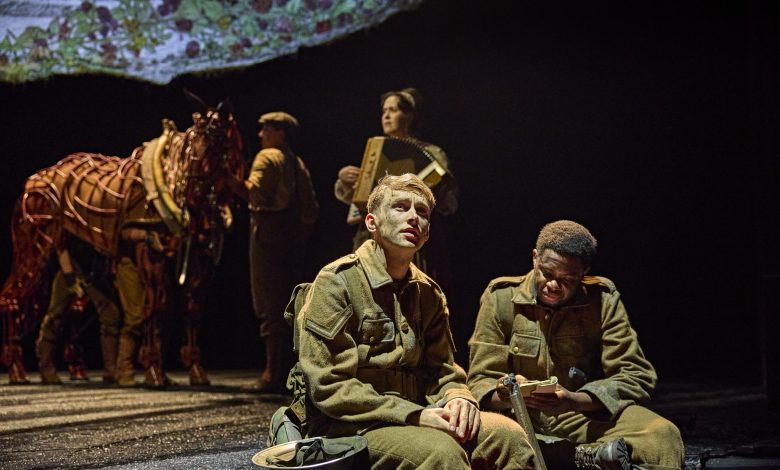War Horse – Norwich Theatre Royal

WAR HORSE: A TIMELESS TALE OF COURAGE AND CONNECTION
In the rich landscape of contemporary theater, “War Horse” stands as a monument to theatrical innovation and emotional storytelling. Based on Michael Morpurgo’s beloved novel and adapted for the stage by Nick Stafford, this production continues to move audiences with its portrayal of the unbreakable bond between a boy and his horse against the brutal backdrop of World War I. Under the direction of Tom Morris and Katie Henry, the show has maintained its place in the theatrical canon for nearly two decades, though the passage of time has brought both perspective and a slight weathering to its once revolutionary approach.
At the heart of “War Horse” is the breathtaking puppetry from the Handspring Puppet Company, which remains the production’s crowning achievement. When Joey, the titular horse, first gallops across the stage—particularly as his fully grown form is revealed—audiences still experience a genuine sense of wonder and awe. The intricate craftsmanship of the puppets and the remarkable synchronization of the puppeteers create an illusion so compelling that viewers quickly forget they’re watching constructed figures manipulated by visible humans. The puppeteers breathe life into these creations with such nuanced movements—the flick of an ear, the heaving of breath, the subtle shifting of weight—that the emotional connection established between audience and animal becomes profoundly real. However, as the performance progresses, what was once revolutionary now carries a hint of familiarity. This isn’t necessarily a criticism but rather an acknowledgment that even the most spectacular technical achievements require strong narrative support to maintain their impact throughout a full-length production.
The human element of “War Horse” is anchored by several standout performances that give emotional weight to this story of love, loss, and reconciliation. Alexander Ballinger’s portrayal of Captain Friedrich emerges as particularly resonant, offering a nuanced exploration of a man caught between military duty and his compassionate concern for the animals in his care. His performance adds unexpected depth to the wartime narrative, moving beyond simple characterizations of heroes and villains to explore the complicated moral territory of armed conflict. Tom Sturgess brings warmth and emotional grounding to Albert, the farm boy whose devotion to Joey drives the narrative forward. His authentic portrayal of youthful determination and unwavering loyalty provides the emotional core around which the entire production revolves. The rest of the large ensemble delivers solid performances throughout, creating a rich tapestry of characters that populate both the rural English countryside and the war-torn battlefields of France.
The staging of “War Horse” attempts to create an immersive experience that pulls audiences into the heart of the action. The production utilizes multimedia elements, including animated drawings projected onto a torn paper backdrop resembling a page from a soldier’s sketchbook, which effectively establishes setting while emphasizing the historical context of the story. The soundscape—featuring folk songs, military drums, and the cacophony of battle—further enhances the atmospheric quality of the production. However, some staging choices present challenges for the audience experience. Certain pivotal moments unfold at the very front of the stage apron or even in front of the stage itself, resulting in partially obscured views for many seated throughout the auditorium. For a production so heavily dependent on visual storytelling and the physical language of the puppets, these moments of limited visibility can diminish the emotional impact of key scenes and create a disconnect just when the audience’s engagement should be most complete.
The thematic power of “War Horse” continues to resonate in our contemporary world. The story’s exploration of the senseless destruction of war, the innocence of those—both human and animal—caught in its machinery, and the remarkable capacity for compassion that can emerge even in humanity’s darkest hours feels eternally relevant. The production poignantly illustrates how animals, particularly the millions of horses that served and died in World War I, were unwitting participants in human conflict. This perspective offers a unique lens through which to view the broader tragedy of war, reminding us that suffering extends beyond human boundaries. The narrative’s ultimate message of resilience, reconciliation, and healing provides a necessary counterbalance to its unflinching portrayal of warfare’s horrors. Through Joey’s journey and his connection with humans on both sides of the conflict, we are reminded of our shared humanity and the possibilities for understanding that exist even across enemy lines.
As “War Horse” gallops toward its extended run through November 2025, it stands as both a testament to theatrical innovation and a reminder that even groundbreaking productions must evolve to maintain their revolutionary impact. For first-time viewers, the production still offers a captivating and emotionally resonant experience that showcases the unique power of live theater to tell stories that film and literature cannot. The remarkable puppetry, compelling performances, and timeless themes continue to create a theatrical experience worthy of attention. For returning audiences, while the surprise of innovation may have faded, the emotional core of the story—the enduring bond between a boy and his horse amid the chaos of war—remains as powerful as ever. Though “War Horse” may no longer be the revelation it once was, it continues to demonstrate why it changed audience expectations and remains an important chapter in contemporary theater history—a production that pushed creative boundaries and opened new possibilities for storytelling on stage.








